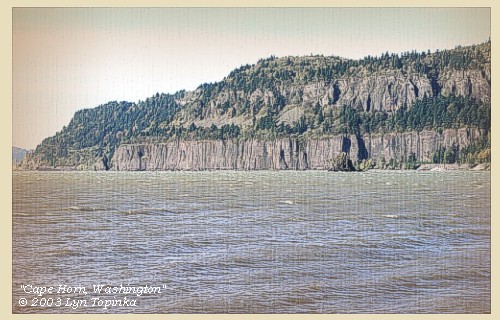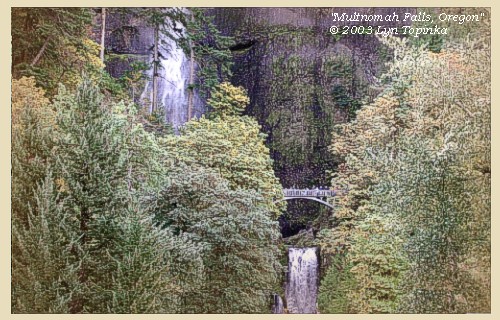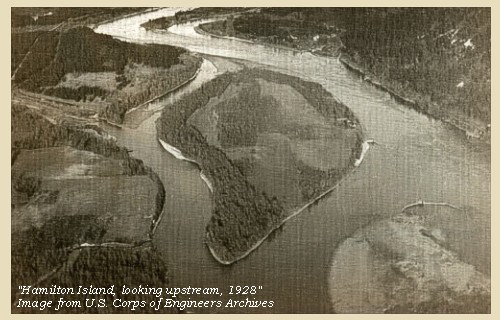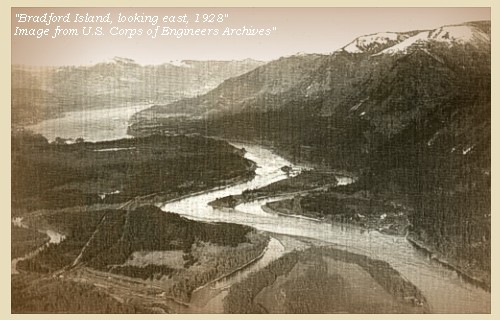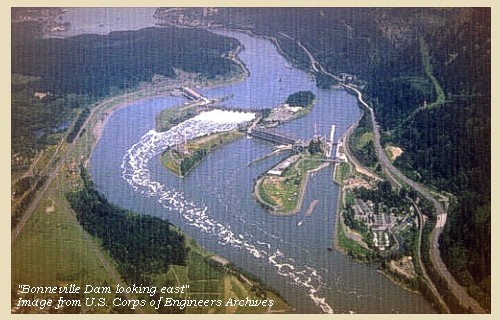The Volcanoes of
Lewis and Clark
Lewis and Clark
|
April 9, 1806 Columbia River Gorge - Shepperd's Dell to Bonneville |
|
Home
The Volcanoes of Lewis and Clark Map of the Journey Volcanoes, Basalt Plateaus, Major Rivers, etc. The Volcanoes Mount Adams, Mount Hood, Mount Jefferson, Mount Rainier, and Mount St. Helens CALENDAR of the Journey October 1805 to June 1806 Along the Journey Pacific Northwest Maps - Columbia River, Volcanoes, Flood Basalts, Missoula Floods, Geology, etc. The Corps of Discovery The Journey of Lewis and Clark About the Reference Materials The Journals, Biddle/Allen, DeVoto, Gass, Moulton, Topo Maps, and others USGS Lewis and Clark Links Links to USGS Websites highlighting the Lewis and Clark Journey Resources Publications Referenced and Websites Visited |
PREVIOUS
April 6-8 Columbia River Gorge, Cottonwood Beach Camp to Shepperd's Dell |
April 9
Columbia River Gorge, Shepperd's Dell to Bonneville Cape Horn, Multnomah Falls, Lava Flows and Gorge Waterfalls, Beacon Rock and Beacon Rock State Park, Hamilton Island, Bradford Island, Bonneville Dam |
CONTINUE
April 10-11 Columbia River Gorge, Bonneville Vicinity |
|
Heading for Home - April 1806
Columbia River Gorge - Shepperd's Dell to Bonneville |
| Lewis and Clarks camp from April 6 through April 8, 1806, was in the area of today's Shepperd's Dell State Park, Oregon. |
| Wednesday, April 9, 1806 |
| The wind having moderated, we reloaded the canoes, and set out by seven o'clock. We stopped to take up two hunters who had left us yesterday, but were unsuccessful in the chase, and then proceeded to the Wahclellah village, situated on the north side of the river, about a mile below Beacon rock. [Beacon Rock] During the whole of the route from our camp, we passed along under high, steep, and rocky sides of the mountains, which now close on each side of the river, forming stupendous precipices [Cape Horn is on the Washington side], covered with the fir and white cedar. |
| Down these heights frequently descend the most beautiful cascades, one of which a large creek, throws itself over a perpendicular rock three hundred feet above the water, while other smaller streams precipitate themselves from a still greater elevation, and evaporating in a mist, again collect and form a second cascade before they reach the bottom of the rocks [Multnomah Falls ???]. We stopped to breakfast at this village. ...... |
| As these people had been very kind to us as we descended the river, we endeavoured to repay them by every attention in our power. After purchasing, with much difficulty, a few dogs and some wappatoo from the Wahclellahs, |
| "... a large creek puts in close above the village which we did not discover last fall [Woodward Creek ???] . when we passd down we dined and proceed. on ..." [Ordway, April 9, 1806] |
| we left them at two o'clock, and passing under the Beacon rock [Beacon Rock], reached in two hours the Clahcellah village. This Beacon rock, which we now observed more accurately than as we descended, stands on the north side of the river, insulated from the hills. The northern side has a partial growth of fir or pine. To the south it rises in an unbroken precipice to the height of seven hundred feet, where it terminates in a sharp point, and may be seen at the distance of twenty miles below. This rock may be considered as the commencement of tide-water, though the influence of the tide is perceptible here in autumn only, at which time the water is low. What the precise difference at those seasons is, we cannot determine; but on examining a rock which we lately passed, and comparing its appearance now with that which we observed last November, we judge the flood of this spring to be twelve feet above the height of the river at that time. From Beacon rock as low as the marshy islands [area of Lewis and Clark National Wildlife Refuge, near the mouth of the Columbia], the general width of the river is from one to two miles, though in many places it is still greater. ...... |
| "... this remarkable rock which stands on the North shore of the river is unconnected with the hills and rises to the hight of seven hundred feet; it has some pine or reather fir timber on it's nothern side, the southern is a precipice of it's whole hight. it rises to a very sharp point and is visible for 20 miles below on the river ..." [Lewis, April 6, 1806] |
| "... at 2 oClock P. M. we set out and passed under the Beacon rock on the North Side of two small Islds. situated nearest the N. side [Two islands of today are Pierce Island and Ives Island.] ..." [Clark, April 9, 1806] |
| As our large canoes could not ascend the rapids on the northside we passed to the opposite shore, and entered the narrow channel which separates it from Brant island [Bradford Island]. |
| "... at 4 P. M. we arived at the first rapid at the head of Strawberry island at which place on the N W. Side of the Columbia here we found the nativs from the last village rebuilding their habitations of the bark of their old village ... as we could not pass with the large canoes up the N.W. Side for the rocks, the wind high and a rainey disagreeable evining. our smallest canoe being too low to cross through the high waves, we sent her up on the N W. Side with Drewyer and the two Fields and after purchaseing 2 dogs crossed and into the sluce of a large high Island seperated from the S.E. Side by a narrow channel. in this chanel we found a good harbor and encamped on the lower side. evening wet & disagreeable ..." [Clark, April 9, 1806] |
| Lewis and Clark have passed "Strawberry Island" (Hamilton Island), and reached Bradford Island, the area of today's Bonneville Dam, and camped on the Oregon side of the Columbia behind Bradford Island, upstream of Tanner Creek and across from the downstream tip of Bradford Island. |
| The weather was very cold and rainy, and the wind so high, that we were afraid to attempt the rapids this evening, and therefore, finding a safe harbour, we encamped for the night [on the Oregon side of the Columbia across from the downstream tip of Bradford Island.]. ...... |
|
|
|
The Camp - April 9, 1806:
Lewis and Clark camped on the Oregon side of the Columbia River, at a location now near the Bonneville Dam, upstream of Tanner Creek and across from the downstream tip of Bradford Island. |
| Home | Previous | Continue |
If you have questions or comments please contact: GS-CVO-WEB@usgs.gov
June/July 2004, Lyn Topinka
The Volcanoes of Lewis and Clark Home Page | CVO Home Page


